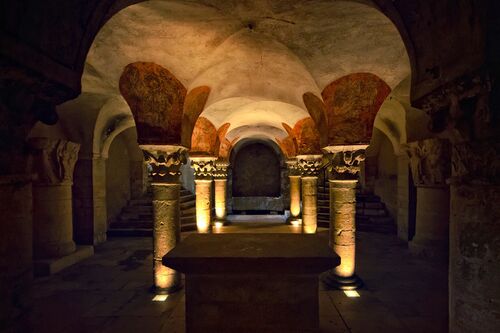Difference between revisions of "Tibecea (Rough Guide)"
Cholmondely (talk | contribs) m (Link) |
Cholmondely (talk | contribs) (Added caption) |
||
| (2 intermediate revisions by the same user not shown) | |||
| Line 1: | Line 1: | ||
[[Image:Tibecea (Coat of Arms).png|right|thumb|''Coat of Arms'']] | [[Image:Tibecea (Coat of Arms).png|right|thumb|''Coat of Arms'']] | ||
| + | [[File:Northern Areas 38b commons.jpg|thumb|320px|right|HoloStim of Mount Ahruman (from the early days of settlement)]] | ||
*Economic status: '''Mainly Industrial''' | *Economic status: '''Mainly Industrial''' | ||
*Technology level: '''8''' | *Technology level: '''8''' | ||
| Line 29: | Line 30: | ||
== Hotels and Hostels == | == Hotels and Hostels == | ||
| + | [[File:Caverns of Rudolpho (Reception).jpg|thumb|right|500px|Caverns of Rudolpho (Reception)]] | ||
*The renowned '''Palazzo Disieti''' is without doubt the most luxurious hotel on Tibecea, renowned amongst the epicures. The Disieti died of assassination a half century ago, and their palace was taken over by cousins who had no use for it. The entrance hall is of polished black marble, lit by silver chandeliers and surrounded by silver mirrors, reflecting the light back to the centre of the hall. The ceiling was painted by '''Arbuthnot of Digebiti''', and represents the heavens immediately above at the time of painting. Tianve's famous pulsar can just be made out with the unaided eye, as can Ceesxe. The bar is festooned with gap-toothed baturas painted on the walls and ceilings. Their '''Lethal Brandy Libation''' is justly renowned - and has travelled far around The Eight from its original home. The dining salon is justly renowned for its '''Zuppa della Zucca''', a gourd potage with a heavenly aroma and small succulent globes of pungent duthri mushrooms sauteed in brandy & cream bobbing just below the surface. Their famous '''Gourmet's Garden''' contains a casserole of delectable root vegetables mixed with the barely glutinous yolks of thrivta eggs topped with a sour cream and dill dressing. One needs to give a day's notice to enjoy the Gourmet's Garden, as the vegetables need be picked and then lengthily marinaded to assure the appropriate sapidity. As for the puddings ... | *The renowned '''Palazzo Disieti''' is without doubt the most luxurious hotel on Tibecea, renowned amongst the epicures. The Disieti died of assassination a half century ago, and their palace was taken over by cousins who had no use for it. The entrance hall is of polished black marble, lit by silver chandeliers and surrounded by silver mirrors, reflecting the light back to the centre of the hall. The ceiling was painted by '''Arbuthnot of Digebiti''', and represents the heavens immediately above at the time of painting. Tianve's famous pulsar can just be made out with the unaided eye, as can Ceesxe. The bar is festooned with gap-toothed baturas painted on the walls and ceilings. Their '''Lethal Brandy Libation''' is justly renowned - and has travelled far around The Eight from its original home. The dining salon is justly renowned for its '''Zuppa della Zucca''', a gourd potage with a heavenly aroma and small succulent globes of pungent duthri mushrooms sauteed in brandy & cream bobbing just below the surface. Their famous '''Gourmet's Garden''' contains a casserole of delectable root vegetables mixed with the barely glutinous yolks of thrivta eggs topped with a sour cream and dill dressing. One needs to give a day's notice to enjoy the Gourmet's Garden, as the vegetables need be picked and then lengthily marinaded to assure the appropriate sapidity. As for the puddings ... | ||
*For those slumming it, the '''Caverns of Rudolpho''' are well worth a visit. Based in the coal scuttles of an ancient factory, the ceilings have been removed from the bedrooms leaving a massive layer of ice between one's bed and the skies above. The light that filters through the thick translucent ice can be quite haunting, as the obscurity of the ice confers a spectral sheen which seems to permeate the rooms. The chutes which used to feed the lower furnaces from these upper scuttles have been rather solidly blocked up with coal, making an interesting talking point. The tea is quite appalling. | *For those slumming it, the '''Caverns of Rudolpho''' are well worth a visit. Based in the coal scuttles of an ancient factory, the ceilings have been removed from the bedrooms leaving a massive layer of ice between one's bed and the skies above. The light that filters through the thick translucent ice can be quite haunting, as the obscurity of the ice confers a spectral sheen which seems to permeate the rooms. The chutes which used to feed the lower furnaces from these upper scuttles have been rather solidly blocked up with coal, making an interesting talking point. The tea is quite appalling. | ||
Latest revision as of 20:06, 11 December 2022
- Economic status: Mainly Industrial
- Technology level: 8
- Population: 3.3 Billion Human Colonials
- Political status: Feudal
- Radius: 4858km
- G: ? standard
- Neighbors (7.0 LY or less): Ceedra, Sori/Ascension, Isdibi, Diquxe, Zaleriza
The Doge of the Celestial Republic of Tibecea is selected for life by the Noble Council, a collection of several hundred scions of nobility, whose families are listed in the Sable Onomasticon, the black book of barons. The election on the Death of the Old Doge is performed using a strict form of proportional representation: the number of votes each scion casts is directly proportional to the amount of land inherited from the grandparents. The Doge then selects the Minor Council (including the Doge, the eight Overseers of the Octant, the magistrates, the trinity of Senior Sacerdotes of the Church of Giles the Creator and the current Poet Laureate) who will rule the system.
The title of the Celestial Republic (La Celestialissima) may seem a tad incongruous as a description of a snowball in space. The name derives from the unparalleled panoramas which existed on settlement, when the views through the clear skies of the heavens above outmatched anything that the new settlers had previously seen. As the settlement extended and the industrial smog grew and grew, obscuring the skies and the heavens beyond, the people never really noticed, ensconced as they were in their underground redoubts. Yet the name remained, to perplex inquisitive visitors.
The palazzi of the aristocracy are quite unusual, and not just in their troglodytic location. Each Palazzo is a little city in itself. It is grouped around the smokestacks, leading up from the lowest part of the palace. Clustered around the warming chimneys are the principal rooms of the noble family - the state rooms, arrayed with objets d'art, designed to impress the visitors and imbue a sense of dignity amongst the blue-blooded inhabitants. Above are the storerooms, where the goods manufactured by the dynastic factories are stored before sale and transportation. Beneath the staterooms are the manufactories themselves, where the fires burn incessantly and the machinery creates the products for sale. Further away from the chimneys are the living quarters of the dependents, as well as the storerooms filled with the raw materials. Melted ice from the surrounds of the smokestack above is funneled down to provide fresh water, and with the growth of hydroponics, more and more food is now grown within the palazzi themselves. The families are split between the Vecchi and the Novi. The old families, the Vecchi, lost control of the Noble Council a century ago. Their wealth is in agriculture (such as it is), the building of machinery for agricultural and constructive purposes, and objets d'art. The newer Novi have established a foothold in trade - enabling cheaper food imports as well as machinery for domestic purposes and less poetic sculptures. They have also established strong business links with the Church of Giles the Creator. The Novi were instrumental in the building of the new cathedral (on the site of the old).
The Church of Giles the Creator is the established religion on Tibecea. Other expressions of religion do indeed exist - a handful of the noble houses have either different or split allegiances in this regard. The main Cathedral is the other end of the planet from the Doge's Palazzo, to restrain the Sacerdotes from interfering in matters of politics. It contains a deep river running through the cathedral where the Blessed Barque is moored in front of the High Altar and the Sacerdotal Throne. This is naturally an old-style cathedral (newer styles have the Blessed Barque much closer to the entrance). The walnut of the barque was imported at great expense from Bemaera. Festooned with Ivory and Walnut, the cathedral is deep underground and entry is forbidden to infidels.
One of most famous Tibecean Sacerdotes, whose memorial in the cathedral has been the focal point for hordes of pilgrims over the centuries, was Saint Phibo Nacci. A divinely inspired theorematist, he claimed that many of the secrets of the Ooniverse could be divined from numerological prestigitations. As one of the trinity of Sacerdotal Hierarchs, Nacci moved further and further away from his administrative responsibilities as he plumbed the mathematical secrets underlying the Oonity of the Ooniverse. His treatise on Theological Arithmetics is justly renowned throughout The Eight.
The Edible Poet Society was founded by Ianbello degli Sciolti some three centuries ago. It is now one of the most prestigious guilds of Tibecea - one of the Grande Agglomerazione. They march third in the Grand Parade behind the Holy Society of Saint Jens and the Society of the Gifted Artesans. Their banner is the Scarlet Standard of Stylistics, and they appear in sable pelts bedecked with ivory canopies. Rediscovering the ekphrastic enjambments of bygone eras, the Society has been shattering modern stereotypes with their imaginative reworkings of traditional set pieces. The Commendatore of the Society is usually chosen as the Poet Laureate.
Degli Sciolti felt strongly that good poetry was best encapsulated through sculpture, and started a trend in symbolising different forms of iambic tetrameters, Archilochians, choliambs and Alcmanian strophes in physical form, using different grades of stone and a variety of petroglyphic techniques to represent the vast array of poetic possibilities. This inaugurated a local fascination with petrine verse, which has proved a valuable export commodity for the society. More recent developments have included mosaics.
The leading guild, the Societa del Santo Jens, is actually the association of pall bearers. The members of the Society under the watchful eye of their patron saint, prepare the deceased for their final voyage with the Blessed Boatman on the Blessed Barque. The embalming, wrapping and myriad meditations performed over the deceased are done with great solemnity and dignity. The members of the society are treated with great honour by those who encounter them on the rare occasions that they are encountered outside their guildhouse. They usually wear ivory masks with the stylised features of Saint Giles engraved upon them.
Every fifth Hundredth Day there is a snowball competition between the denizens of the Eight Octants. The populace, dressed in their traditional fur coats, assemble at the lower plateau of Mount Ahruman. As they watch, the regional champions roll a large snowball up the lower slopes of the Mountain, accumulating mass as they roll. It is not unknown for the opposition to secretly ice part of the slopes, in the hope that the opposing champions will slip and be crushed beneath their snowball as it reverses and makes its way back down the slope. The largest snowball to make it to the top wins the championship (within the time specified by the Knucklebones of Negation) and the regional roller is feted on the triumphant return to their octant. It is not unknown for fights to occur when matters look as though they have been manipulated in one interest or another, and the death toll can run into the dozens.
It is also not uncommon for the Minor Council to purposefully arrange for a snowball competition for visiting dignitaries, to provide sport and honour them with a spectacle. The last such was the visit of Sir Cody (Bart.) of El Viejo O.O.O.O. (Officer of the Order of the Opulent Ooniverse) with his boon companion Lord Milo of Maregeis, Grand Knight Commander of the Beatific Order of the Besters of the Barbaric Bots. That snowball competition lasted for three hours and witnessed 39 deaths (three by defenestration), eighty-seven shattered limbs and forty-four broken ribs. It was widely acclaimed as one of the best such spectacles for several decades.
Hotels and Hostels
- The renowned Palazzo Disieti is without doubt the most luxurious hotel on Tibecea, renowned amongst the epicures. The Disieti died of assassination a half century ago, and their palace was taken over by cousins who had no use for it. The entrance hall is of polished black marble, lit by silver chandeliers and surrounded by silver mirrors, reflecting the light back to the centre of the hall. The ceiling was painted by Arbuthnot of Digebiti, and represents the heavens immediately above at the time of painting. Tianve's famous pulsar can just be made out with the unaided eye, as can Ceesxe. The bar is festooned with gap-toothed baturas painted on the walls and ceilings. Their Lethal Brandy Libation is justly renowned - and has travelled far around The Eight from its original home. The dining salon is justly renowned for its Zuppa della Zucca, a gourd potage with a heavenly aroma and small succulent globes of pungent duthri mushrooms sauteed in brandy & cream bobbing just below the surface. Their famous Gourmet's Garden contains a casserole of delectable root vegetables mixed with the barely glutinous yolks of thrivta eggs topped with a sour cream and dill dressing. One needs to give a day's notice to enjoy the Gourmet's Garden, as the vegetables need be picked and then lengthily marinaded to assure the appropriate sapidity. As for the puddings ...
- For those slumming it, the Caverns of Rudolpho are well worth a visit. Based in the coal scuttles of an ancient factory, the ceilings have been removed from the bedrooms leaving a massive layer of ice between one's bed and the skies above. The light that filters through the thick translucent ice can be quite haunting, as the obscurity of the ice confers a spectral sheen which seems to permeate the rooms. The chutes which used to feed the lower furnaces from these upper scuttles have been rather solidly blocked up with coal, making an interesting talking point. The tea is quite appalling.
Cuisine
- The local ice-wine is well worth trying. Try to avoid that from the eastern vineyards as the placement of many is rather too close to the notorious suburbs of Murghero, whose smoke stacks stain the air for leagues around, hampering the light reaching the leaves of the bines.
- As well as the justly renowned Zucca mentioned above, the local truffle - la marquesa - which is carefully grown in insulated orchards on the slopes of the Cimorrisian mountain range has an aroma which is treasured. One can see local grandmothers carefully inspecting the tubers in the local markets, sniffing them to see which is best.
- Following the legendary Italian excellence in preparing coffee, the local coffee is well worth trying. Note that prices are considerably cheaper if you do not drink the coffee inside the coffee house.
Places to visit
Apart from the New Cathedral and the Doges' Palace (entrance can be negotiated with the Ducal Guard for a price), the Guild Hall of the Society of Orphans is on every discerning visitor's list. A minor guild, it harboured Francesco della Rindola, a famous sculptor whose works grace many of the palaces in The Eight. He carved twenty-seven of the doges from polished sandstone, with a breath-taking command of fine details and nuance. One can almost see the whiskers of Doge Alberto III quiver in the icy winds above! The Guild Hall contains all of della Rindola's ducal originals, which can be viewed for a modest sum which goes to the upkeep of the current orphans.
Also of note is the maze of Adolpho. Set in an immense underground hall, supported by hewn pillars with barleytwist columns and vegetative capitals interspersed with lamps of a verdant hue, the hedges, bridges and streams of the maze provide hours of enjoyment (or frustration!) for those that delve to find its inner secrets. At the very middle is a platinum tower from where one can look down and see the paths unravelled before one's very eyes. Every threeday a band stands on the lower crenellations playing popular favourites. Coffee from the Doge's favourite variety is available at the summit of the tower.
Pages in the Rough Guide to the Ooniverse.
|



